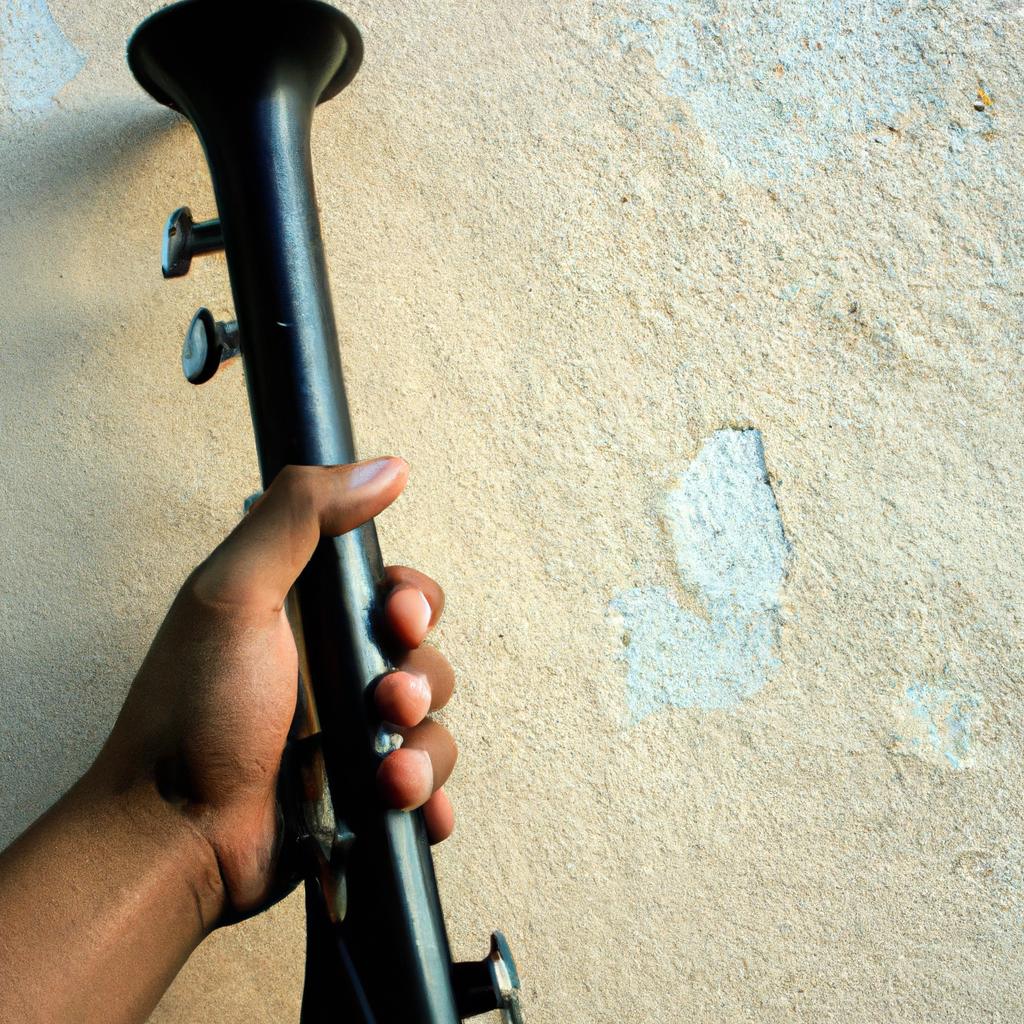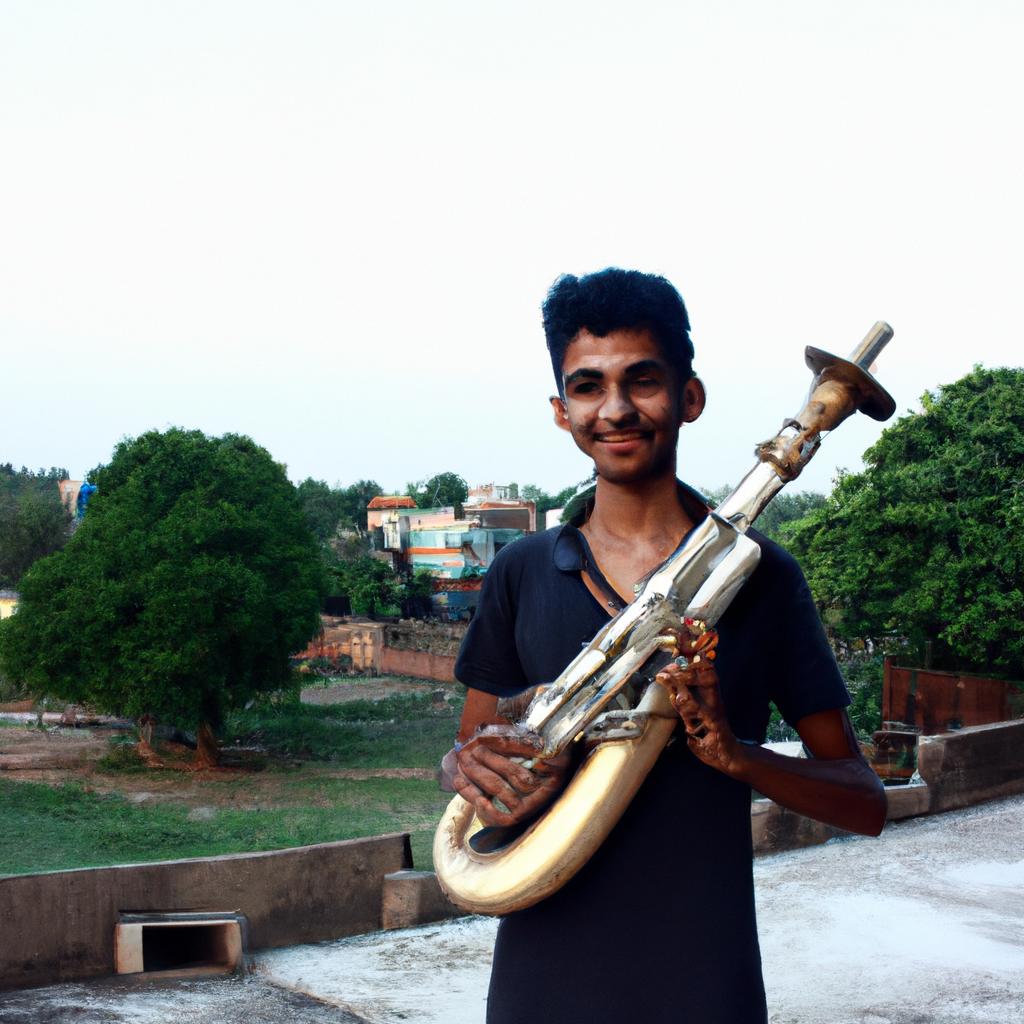Financial planning is a crucial aspect for artists seeking to sustain their creative endeavors and achieve long-term success. This article presents a comprehensive guide to musical financing, focusing specifically on the White Wizzard Band as an illustrative example of effective financial management within the music industry. By examining the band’s experiences in navigating the complexities of budgeting, fundraising, and revenue generation, this article aims to equip aspiring musicians with practical insights and strategies for sustainable financial planning.
To understand the importance of financial planning in the context of music production, consider the hypothetical case study of the White Wizzard Band. Composed of talented musicians aiming to create high-quality metal music, they encounter various financial challenges throughout their career journey. From recording costs and equipment purchases to tour expenses and marketing campaigns, these artistic ventures require substantial monetary investments. Without adequate financial planning, such endeavors may become financially burdensome or even unfeasible, hindering artists from reaching their full potential.
Thus, it becomes essential for artists like the members of White Wizzard Band to develop a meticulous approach towards managing their finances. By adopting effective budgeting techniques tailored to their specific needs and goals, they can allocate resources wisely while minimizing unnecessary expenditures. Moreover, understanding different avenues for raising funds such as crowdfunding platforms or sponsorship opportunities can significantly alleviate financial strain. By carefully assessing the viability of these options and strategically leveraging them, artists can secure additional funding to support their creative projects.
In addition to budgeting and fundraising, revenue generation is another crucial aspect of financial planning for musicians. The White Wizzard Band, for example, explores various income streams such as album sales, merchandise sales, ticket sales from live performances, licensing deals, and streaming royalties. Diversifying revenue sources not only helps mitigate the risks associated with relying on a single income stream but also maximizes potential earnings.
Furthermore, effective financial planning involves monitoring and analyzing key performance indicators (KPIs) to gauge the success and profitability of artistic endeavors. By tracking metrics such as album sales, attendance at live shows, and online engagement metrics like streaming numbers or social media followership, artists can gain valuable insights into their audience’s preferences and adjust their strategies accordingly. This data-driven approach enables artists to make informed decisions about future investments in projects that have the highest potential for financial returns.
Lastly, it is important for artists to consider long-term financial stability by setting aside savings or investing in retirement accounts. While the music industry can be unpredictable and volatile, having a solid financial foundation ensures that artists are prepared for unforeseen circumstances or periods of low income.
Ultimately, financial planning plays a vital role in supporting artists’ creative pursuits by providing them with stability and resources to bring their visions to life. Through careful budgeting, strategic fundraising efforts, diversified revenue generation tactics, and ongoing analysis of KPIs, artists can navigate the complexities of the music industry while maintaining sustainable financial health.
Understanding the Financial Challenges Faced by Artists
Financial challenges are a common aspect of an artist’s journey, and musicians, like the White Wizzard band, often encounter various obstacles in their pursuit of success. To illustrate this point, let us consider a hypothetical scenario involving a talented young musician named Alex. Despite having exceptional musical abilities, Alex struggles to finance his music career due to limited resources and lack of financial knowledge.
Financial Constraints:
One significant challenge artists face is the scarcity of funds to support their artistic endeavors. This can include expenses such as instrument purchases, studio rentals, marketing campaigns, touring costs, and production fees for albums or singles. In Alex’s case, he finds it difficult to afford quality recording equipment and professional mixing services essential for producing high-quality tracks that could help him gain recognition within the industry.
Unpredictable Income:
Another obstacle faced by artists is the irregularity of income streams. Many musicians rely on gigs and performances as their primary source of revenue; however, these opportunities may be sporadic and uncertain. As a result, maintaining stable finances becomes challenging. For instance, even if Alex manages to secure regular gigs at local venues, there might still be periods when no performance offers arise due to seasonal fluctuations or unforeseen circumstances.
Lack of Financial Literacy:
A general lack of financial literacy among artists exacerbates these challenges further. Unlike traditional careers with well-defined paths towards financial stability and retirement planning options, many artists find themselves navigating unfamiliar territory without proper guidance. They often struggle with budgeting effectively or understanding tax responsibilities associated with self-employment income. Alex faces similar difficulties as he lacks the necessary knowledge about managing his finances efficiently.
Emotional Response:
To fully comprehend the emotional toll these challenges can take on artists like Alex, consider the following bullet points:
- Constant stress over financial insecurity
- Feelings of frustration caused by setbacks in pursuing artistic goals
- Anxiety stemming from uncertainty regarding future income
- Overwhelm due to the need to balance creative pursuits with financial obligations
To emphasize this emotional aspect, let us also present a table highlighting potential financial challenges faced by artists:
| Financial Challenges | Impact on Artists |
|---|---|
| Limited funding | Hinders artistic growth and development |
| Irregular income | Causes financial instability and stress |
| Lack of knowledge | Impedes effective financial planning and decision-making |
| Balancing act | Strains mental well-being and creativity |
Understanding these financial hurdles is crucial for addressing them effectively. By recognizing the specific challenges faced by artists like Alex, we can now explore strategies to overcome them.
Setting Financial Goals for the Band
Artists, including musicians like the White Wizzard band, often face significant financial challenges in their careers. Whether it’s funding a new album, booking tour dates, or simply making ends meet, artists must navigate a complex landscape to ensure their artistic endeavors are financially sustainable. To illustrate these challenges, let’s consider the hypothetical case of an emerging rock band looking to finance their debut album.
One major challenge faced by artists is securing sufficient funds for recording and production costs. A typical studio album can cost anywhere from $10,000 to $100,000 or more depending on factors such as studio fees, producer fees, equipment rental, mixing and mastering services, artwork design, and physical CD production. This requires careful budgeting and resource allocation to avoid going overboard with expenses while still ensuring quality output.
In addition to recording costs, artists also need to allocate funds for marketing and promotion. Without effective promotion strategies in place, even the most talented musicians may struggle to gain visibility and attract a larger audience. Marketing efforts include activities such as creating press kits and promotional materials (e.g., posters and flyers), hiring publicists or marketing agencies to secure media coverage and interviews, running social media campaigns or online ads, organizing release parties or concerts for generating buzz around the album release.
To further complicate matters, many artists rely heavily on income generated through live performances. However, due to the ongoing COVID-19 pandemic or other unforeseen circumstances like venue closures or low attendance rates at shows—artists have experienced significant setbacks in terms of canceled gigs and reduced revenue streams.
Navigating these financial challenges requires careful planning and consideration of various aspects that impact an artist’s overall financial health. Here are some key points to keep in mind:
-
Diversify Income Streams: Explore different avenues beyond just music sales for generating revenue such as merchandise sales (t-shirts, posters), crowdfunding campaigns (Kickstarter, Patreon), sponsorships or endorsements, and licensing opportunities for film, TV, or commercials.
-
Build a Strong Support Network: Surround yourself with professionals who can provide valuable guidance in areas such as finance management, legal matters (contracts and copyrights), booking agents or managers to secure gigs, and accountants specialized in the music industry.
-
Develop Financial Literacy: Educate yourself on financial planning basics like budgeting, investment strategies, tax obligations specific to artists, and royalty collection mechanisms so that you can make informed decisions about your finances.
-
Seek Grant Opportunities: Research grant programs specifically aimed at supporting artists and musicians. Many organizations offer grants for recording projects, touring expenses, equipment purchases, or career development initiatives.
By understanding these challenges and implementing strategic financial planning measures tailored to their needs as artists, bands like White Wizzard can navigate the complexities of the music industry more effectively while ensuring long-term financial stability.
Now let’s delve into creating a realistic budget for recording and production costs – an essential step towards financing any musical project successfully.
Creating a Budget for Recording and Production
Building on the financial goals set for the band, it is crucial to create a well-planned budget for recording and production. This ensures that resources are allocated effectively and maximizes the potential of delivering high-quality music. To illustrate this process, let’s consider the case study of White Wizzard Band, an up-and-coming heavy metal group aiming to produce their debut album.
The first step in creating a budget for recording and production is to identify all the necessary expenses involved. These can vary depending on factors such as studio fees, equipment rentals, session musicians’ costs, mixing/mastering charges, artwork design, manufacturing CDs or vinyl records, and promotional activities. By meticulously listing these items out, bands can have a clearer picture of what needs to be covered financially.
To better understand the significance of careful planning when it comes to finances in music production, here are some key points worth considering:
- Financial stability during the recording stage allows artists to focus on making creative decisions rather than compromising due to budget constraints.
- A realistic budget minimizes unexpected financial burdens during the production phase.
- Proper allocation of funds enables artists to invest in various aspects of production without sacrificing quality.
- Strategic financial planning helps maintain transparency within the band regarding expenses and avoids misunderstandings or conflicts.
To further highlight how meticulous budgeting plays a vital role in successful music projects like White Wizzard Band’s upcoming album release, refer to Table 1 below showcasing estimated costs associated with different elements of recording and production:
Table 1: Estimated Costs for Recording and Production
| Item | Cost |
|---|---|
| Studio Fees | $10,000 |
| Equipment Rentals | $5,000 |
| Session Musicians | $3,500 |
| Mixing/Mastering | $7,000 |
| Artwork Design | $2,000 |
| CD/Vinyl Manufacturing | $4,500 |
| Promotional Materials | $2,500 |
| Total | $34,500 |
By having a clear breakdown of the estimated costs involved in recording and production, bands like White Wizzard can be better prepared to make informed financial decisions. This not only allows them to stay within their budget but also ensures that they have adequate funds allocated for each aspect of the album’s creation.
With a well-defined budget in place for recording and production, the next step is exploring funding options for tours and live performances. By carefully managing finances throughout all stages of music creation, artists can optimize their chances of success and sustainability.
Exploring Funding Options for Tours and Live Performances
After creating a budget for recording and production, it is crucial for artists to explore funding options that can support their tours and live performances. One hypothetical example of an artist seeking financial assistance is the White Wizzard band, known for their energetic live shows and captivating stage presence. In this section, we will discuss various avenues through which artists like the White Wizzard band can secure funding for their tours and live performances.
Funding Options:
-
Grants and Scholarships:
- Many organizations offer grants and scholarships specifically designed to support musicians in touring or performing live.
- These opportunities often require submitting applications with detailed proposals outlining how the funds will be used.
- Examples include the MusiCares Foundation’s Emergency Financial Assistance Program and the National Endowment for the Arts’ Touring Grant program.
-
Sponsorship:
- Artists can seek sponsorship from companies or brands interested in supporting music events.
- This arrangement involves promoting the sponsor’s products or services in exchange for financial backing.
- Sponsors might provide funding directly or cover expenses such as travel, accommodation, or equipment rental.
-
Crowdfunding:
- Utilizing online platforms like Kickstarter or GoFundMe allows artists to engage their fan base directly.
- Artists can set fundraising goals, explain why they need financial support, and offer unique rewards to contributors.
- Engaging fans in this way not only generates funds but also fosters a sense of community around the artist’s work.
-
Partnerships with Venues or Booking Agents:
- Establishing partnerships with venues or booking agents can lead to financial support for tours and live performances.
- Some venues may offer guarantees against ticket sales while others provide promotional assistance.
- Booking agents can help secure performance opportunities and negotiate deals that benefit both parties involved.
Table: Potential Funding Sources
| Funding Source | Description |
|---|---|
| Grants and Scholarships | Opportunities provided by organizations for musicians to receive financial assistance. |
| Sponsorship | Financial backing from companies or brands in exchange for promotional benefits. |
| Crowdfunding | Engaging fans through online platforms to raise funds directly from the community. |
| Partnerships with Venues or Booking Agents | Collaborations that provide financial support, guarantees, or promotional assistance. |
Exploring funding options is an essential part of a comprehensive financial plan for artists like the White Wizzard band. However, securing funds is only one aspect of managing their finances effectively. In the following section, we will delve into strategies for managing income streams and royalties to ensure long-term financial stability.
[Start next section on Managing Income Streams and Royalties]
Managing Income Streams and Royalties
Transitioning from the previous section that discussed various funding options, let’s delve deeper into how artists can secure financial resources specifically for tours and live performances. To illustrate this, consider a hypothetical case study of the White Wizzard Band, an up-and-coming rock group seeking funds to embark on their first international tour.
One effective way for artists like the White Wizzard Band to fund their tours is through sponsorships or endorsements. By partnering with relevant companies or brands in the music industry, such as instrument manufacturers or clothing labels, artists can gain financial support in exchange for promoting these sponsors during their performances. For example, if the band were to strike a deal with a guitar manufacturer, they might receive free equipment or monetary compensation in return for displaying the brand prominently on stage and in promotional material.
In addition to sponsorships, crowdfunding has emerged as another popular option for artists looking to finance their tours. Platforms like Kickstarter or Patreon allow fans and supporters to contribute financially towards specific projects or goals. The White Wizzard Band could create a campaign on one of these platforms where they offer exclusive perks, such as limited-edition merchandise or backstage access, to incentivize fans to donate money towards their upcoming tour expenses.
To further explore funding possibilities, here are some emotional bullet points:
- Increased exposure through touring helps build a loyal fan base.
- Financial constraints may limit opportunities for growth and artistic development.
- Independent artists often struggle with finding adequate funding sources.
- Investing in quality production values enhances concert experiences.
Now let’s take a closer look at potential funding avenues by examining a table highlighting different options available:
| Funding Option | Description | Pros | Cons |
|---|---|---|---|
| Sponsorship/Endorsement | Collaboration with relevant brands | Provides financial support | Limited availability; requires negotiations |
| Crowdfunding | Fans and supporters contribute financially | Engages fans; potential for viral reach | Success not guaranteed; time-consuming |
| Grants | Government or private funding | Free money without repayment | Competitive application process |
| Touring Partnerships | Collaborating with other artists/bands | Shared expenses and resources | Finding compatible partners can be challenging |
By exploring these funding options, the White Wizzard Band has a greater chance of securing financial support for their upcoming tour. It is important to carefully consider each avenue’s pros and cons, as well as align them with the band’s goals and values.
Now that we have discussed funding options specifically for tours and live performances, let’s shift our focus towards managing income streams and royalties to ensure long-term financial stability.
Planning for Long-Term Financial Stability
Having discussed the various strategies artists can employ to manage their income streams and royalties effectively, it is now crucial to explore how they can plan for long-term financial stability. By implementing comprehensive financial planning techniques, artists like the members of the White Wizzard band can ensure a sustainable career in the competitive music industry.
Section H2: Planning for Long-Term Financial Stability
To illustrate the importance of long-term financial planning, let us consider a hypothetical scenario involving the White Wizzard band. As their popularity soared, they began earning substantial incomes from album sales, live performances, merchandise, and licensing deals. However, without proper financial planning, their success could be short-lived.
One way an artist or band can achieve long-term financial stability is by diversifying their income sources:
- Exploring new revenue streams such as sponsorships or endorsements.
- Building a loyal fan base that supports crowdfunding efforts.
- Investing in intellectual property rights management to generate passive income through licensing opportunities.
- Collaborating with other musicians or bands on joint ventures to expand their reach.
Consider these factors when planning your finances:
- Achieving peace of mind through secure savings and investments
- Protecting your artistic legacy for future generations
- Creating a stable foundation that allows you to focus on creative endeavors
- Ensuring an equitable distribution of wealth within your team
| Factors | Benefits |
|---|---|
| Secure Savings and Investments | Peace of Mind |
| Artistic Legacy Preservation | Future Generations |
| Stable Foundation | Enhanced Creativity |
| Equitable Wealth Distribution | Harmonious Team Dynamics |
By considering these emotional aspects along with practical financial considerations, artists can create a well-rounded approach to long-term financial stability. This proactive approach will not only secure their future but also provide additional peace of mind, allowing them to focus on what they do best – creating music that resonates with their audience.
Incorporating comprehensive financial planning techniques and taking into account emotional factors can significantly impact an artist’s long-term success. By diversifying income sources, protecting artistic legacies, and fostering a stable foundation, artists like the White Wizzard band can create a sustainable career in the ever-changing landscape of the music industry. Through careful consideration of these strategies, artists can ensure both financial stability and creative freedom for years to come.










